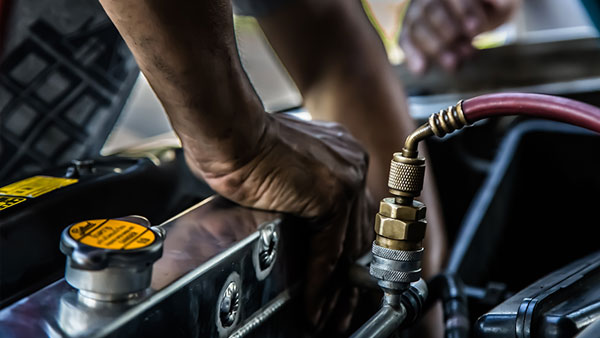AUTO REPAIRS – Radiator and Cooling Systems
You noticed an irregular water puddle under your vehicle that you think comes from your radiator?
YOUR VEHICLE’S COOLING SYSTEM IS ESSENTIAL TO PREVENT THE ENGINE FROM OVERHEATING
Since combustion engines can reach extremely high temperatures, the resulting heat needs to be dissipated. Most recent vehicles have a pressurized engine cooling system that is essential to prevent the engine from burning out.
The cooling system also works to regulate the temperature inside the passenger compartment, ensuring your comfort and that of your passengers.

SIGNS OF POTENTIAL ISSUES RELATED TO THE COOLING SYSTEM
- Temperature gauge indicating above-normal engine temperature
- Pool of green, orange or yellow fluid under your vehicle possibly indicating a cooling system leak
- No or little heat in the passenger compartment
- The “Coolant” warning light is on in the dashboard
Have you noticed one or more of these issues on your vehicle?
Book an appointment with our experts now.
THE “COOLANT” WARNING LIGHT
When this light comes on in the dashboard, it usually indicates that the level of coolant in your vehicle’s radiator is low and must be topped up. YOU MUST NEVER OPEN THE RADIATOR CAP WHEN THE ENGINE IS HOT! As the cooling system is pressurized, it could spray you with boiling coolant.
When the engine is cool, you can use pre-mixed coolant or distilled water to top up the tank. Avoid using tap water to prevent calcium deposits within the radiator, which will decrease its efficiency and could cause the system’s failure. It is always recommended to use pre-mixed coolant that acts both as an antifreeze in winter and a corrosion inhibitor.
You should not attempt to service or repair the system yourself. This requires specific tools and specific training—and that’s exactly what Autotech Performance offers you.
LEARN MORE ABOUT THE COOLING SYSTEM
THE MAIN COMPONENTS OF THE ENGINE COOLING SYSTEM
- Radiator
- Cooling fluid or coolant
- Fan
- Radiator hoses
- Water pump
- Heater core
- Temperature knob
- Temperature control valve
- Thermostat
- Coolant temperature gauge
- Temperature sensor
- Reservoir or reserve tank
- Radiator pressure cap

HOW DOES THE COOLING SYSTEM WORK?
The radiator is the main component of the cooling system. The cooling fluid (or coolant) flows through the inner core of the radiator and transfers its heat to the metal cooling fins that surround the core. The airflow provided by the radiator fan passes through the fins and dissipates the heat from the coolant.
Cooling fluid is usually deep green in colour, but recent coolant formulae are the colour of rusty water. Note that it is important to use a type of cooling fluid that is recommended for your vehicle’s particular model. You must not mix different types of coolants.
The radiator hoses link the upper and lower parts of the radiator to the engine so that the coolant can flow to the engine and return to the radiator.
The water pump circulates the coolant around the cooling system and into the engine block. It is usually activated by either a belt located on the crank pulley or a timing belt that turns at about the same rpm as the engine.
The heater core is a small device located under the dashboard in the passenger compartment. The temperature knob on the instrument panel regulates the temperature control valve located in the engine compartment. Turning the knob toward the warmer setting opens the temperature control valve, allowing coolant from the engine to circulate through the heater core and warm the interior of the car. Inversely, turning the temperature knob toward the cold setting closes the temperature control valve, allowing cool air from the air conditioning system (if the car is equipped with it) to flow through the heater core and cool the passenger compartment.
The thermostat is located in the engine in line with the upper radiator hose. Its purpose is to maintain the coolant and, therefore, the engine at proper operating temperatures. Note that the engine thermostat is not linked to the temperature knob that the driver controls. When the engine is cold, the thermostat is closed, meaning that the coolant is circulated only through the engine and the heater core, bypassing the radiator. This is to prioritize engine warming and efficient use of the defroster and heater in the passenger compartment. Once the engine has reached its optimum operating temperature, the thermostat slowly opens allowing the coolant to flow through the radiator to prevent the temperature from rising any higher. As the engine continues to run, the thermostat constantly controls the flow of coolant to the radiator to maintain an optimal engine temperature. For instance, the thermostat will open when the engine temperature rises—such as when you are stuck in traffic—and close when the engine cools—such as when you are cruising on the highway.
The temperature gauge, located on the instrument panel, is linked to a sensor located on the engine block. This sensor registers variable levels of electrical resistance as the engine heats up, and accurately monitors engine temperature.
An overflow bottle is used as a reservoir for the coolant as it expands and contracts within the system. Hot coolant expands as it enters the radiator, and the resulting overflow is directed to this reservoir. Inversely, when the radiator cools down, the coolant contracts and induces a vacuum within the radiator that is filled by pulling in coolant from this same reservoir. As the reserve tank tends to collect residue from the cooling system, it must be cleaned when the coolant is changed.
The radiator cap closes the filling opening of the radiator through which the coolant is poured. It is designed to seal the cooling system to a specific pressure to ensure the cooling system runs smoothly.
You noticed that your engine’s temperature is too high? You feel that your car’s not heating up properly?
Our experts are there for you!



